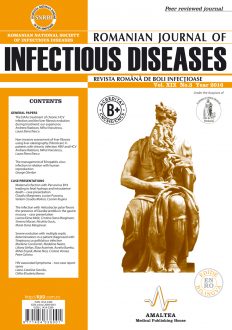SELECT ISSUE

Indexed

| |

|
|
|
| |
|
|
|

|
|
|
|
|
|
| |
|
|
HIGHLIGHTS
National Awards “Science and Research”
NEW! RJID has announced the annually National Award for "Science and Research" for the best scientific articles published throughout the year in the official journal.
Read the Recommendations for the Conduct, Reporting, Editing, and Publication of Scholarly work in Medical Journals.
The published medical research literature is a global public good. Medical journal editors have a social responsibility to promote global health by publishing, whenever possible, research that furthers health worldwide.
THE DAAS TREATMENT OF CHRONIC HCV INFECTION AND THE LIVER FIBROSIS EVOLUTION DURING TREATMENT: OUR EXPERIENCE
Andreea Rădășan, Laura Elena Iliescu and Mihai Voiculescu
ABSTRACT
Introduction. Hepatitis C is a liver inflammation caused by hepatitis C virus. HCV is about 10 times as infectious as HIV. The acute infection rarely causes symptoms and can clear up spontaneously in the first six months in about 20% of those affected. In most cases, however, the infection becomes chronic (up to 80%)6. Chronic hepatitis C is a major cause of liver cirrhosis and hepatocellular carcinoma worldwide7. In the past decades, the standard treatment for hepatitis C viral infection was PEG-IFN and ribavirin (RBV). The future for the treatment of chronic hepatitis C infection is represented by DAAs and for Romania, the future is called Exviera+Viekirax.
Objective of the study: The main purpose of the survaillance was to determine how these HCV chronic infection patients with F4 liver fibrosis tolerate the new DAAs treatment and how the liver fibrosis will decrease or increase.
Matherial and methods: The study enrolled 33 patients from Internal Medicine Center, Fundeni Clinical Institute, during the time period 02.2016 – 08.2016. We evaluated the inflammatory syndrome, the cholestatic syndrome and the evolution of liver fibrosis.
Results: We have noticed a significant decrease of inflammatory syndrome, the bilirubin level decreased also, but the stage of liver fibrosis remained the same, at the end of treatment with Eviera+Viekirax.
Conclusions: We had a small experience so far, with Exviera+Viekirax regimen. The patients tolerated very well the therapy and the virological response was 100% for all subjects.
Keywords: hepatitis, HCV infection, therapy, liver fibrosis, evolution
Full text | PDF
